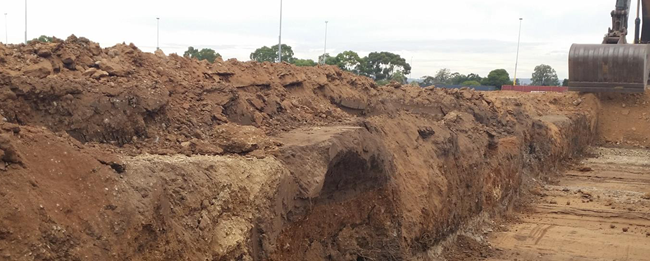Soil Disposal: Reduce, re-use and recycle to save money
Managing soil waste can be a critical concern in property development given significant disposal costs can be incurred, especially when disposing of contaminated soil. Soil disposal costs can range between $20 and $60 per tonne for clean natural soil or can be between $200 and $1,000 per tonne for contaminated soil according to the soil’s risk profile. Considering that an excavation for a basement car park could generate a few thousand tonnes of soil waste, it makes a lot of sense to take a strategic approach to soil waste.
In NSW, soil disposal is regulated in accordance with the Protection of the Environment Operations Act 1997 (POEO Act) and the Protection of the Environment Operations (Waste) Regulation 2014 (Waste Regulation). Heavy fines can result from illegally accepting or disposing of contaminated soil but the regulatory framework also seeks to promote soil reuse or recycling which provides opportunities to reduce disposal costs.
Waste Disposal Framework
The waste regulations framework is designed to promote the following hierarchy set out in the Waste Avoidance and Resource Recovery Act 2001:
- Waste Avoidance;
- Resource Recovery; and
- Disposal.
Waste Avoidance
The avoidance of waste soils may be achieved through careful design, including:
- Designing to the existing topography of a site to avoid the necessity of cut and fill; and
- Developing a balanced cut and fill plan to minimise the transport of waste.
Resource Recovery – Onsite Reuse
When excess soil is excavated, reuse onsite is preferred to offsite reuse. Strategies to maximise onsite reuse include:
- Screening of construction waste or other debris from soil to improve its reusability as fill;
- Undertaking site specific risk assessment to determine if contaminated fill can be reused without resulting in adverse human health or environmental effects;
- Undertaking onsite remediation of contaminated soils for reuse as fill; and/or
- Management of contaminated soils in an onsite containment cell subject to restrictions and legally required documentation.
Resource Recovery – Offsite Reuse
Virgin Excavated Natural Material (VENM) is uncontaminated natural soil not containing sulfidic ores, acid sulfate soils or natural asbestos and is considered inherently suitable for offsite reuse.
Where practical, excavation of a borrow pit to allow offsite disposal of VENM in lieu of other soils may be a suitable cost reduction strategy for efficient resource recovery.
Other offsite reuses of waste soil are regulated through the resource recovery framework which consist of resource recovery exemptions that allow selected wastes to be beneficially and safely reused. The most relevant exemption to soil waste is the Excavated Natural Material (ENM) exemption. The ENM exemption is intended to facilitate the reuse of soil waste suitable for engineered fill and earthworks. A strict testing regime is required to determine if soil meets the requirements for ENM.
Where soil may be suitable for offsite reuse, but an existing resource recovery exemption is not met, application may be made to the NSW EPA for a site specific resource recovery exemption.
Resource Recovery – Soil Recycling
Soil not suitable for offsite reuse under a resource recovery exemption may be suitable for treatment at a soil recycler. In NSW, each soil recycler has an individual licence under the POEO Act for the treatment of soil waste and for the criteria under which they may accept soil waste.
There is no unified classification program for soil which may be accepted by a recycler. Common names such as “Recyclable Soil” and “GSW Recyclable” are not defined in NSW law or EPA regulations and do not represent a standardised waste type.
Disposal
Excavated soil wastes which cannot be reused onsite, reused offsite or transported to a soil recycler for treatment must be transported to landfill. Prior to disposal, all soil waste must be classified in accordance with the NSW EPA Waste Classification Guidelines. While it can be expensive to dispose of soil waste, there are heavy fines for landholders who accept or illegally dispose of contaminated fill.
Soil will typically be classified in one of three broad categories based on the degree of contamination:
- GSW – General Solid Waste (non-putrescible);
- RSW – Restricted Solid Waste; or
- HW – Hazardous Waste.
Soil containing any amount of asbestos is considered Special Waste, and must be classified as Special Waste (Asbestos) in the relevant GSW, RSW or HW category for disposal to a properly licensed landfill facility, i.e. “Special Waste (Asbestos) in the GSW category”. Once classified, soil waste disposal can only be made at a landfill facility licensed to accept the relevant waste type.
Who can assess soil?
Determining waste classifications and exemptions can be complicated and a suitably qualified consultant must classify soil before it can be legally disposed. Our waste classification flyer depicts some of the intricacies of soil classification. You can also contact us for detailed advice regarding your site.
The contamination specialists at Geo-Logix can ensure you maintain your duty of care with the most cost-effective soil disposal option available. View our services here or call Ben Pearce on 02 9979 1722 for assistance with your project.

